
All categories
Featured selections
Trade Assurance
Buyer Central
Help Center
Get the app
Become a supplier

(433 products available)




































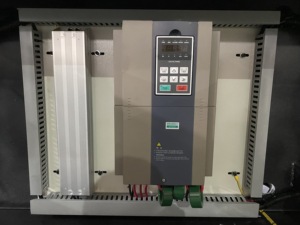


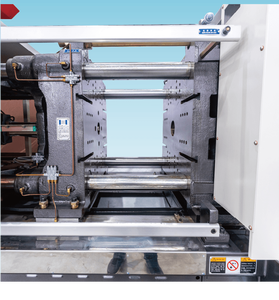
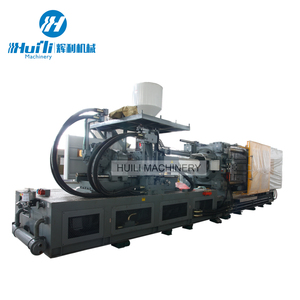

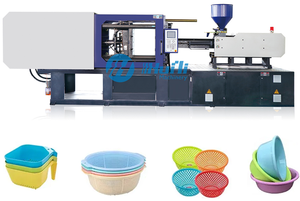






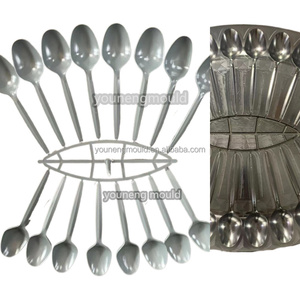

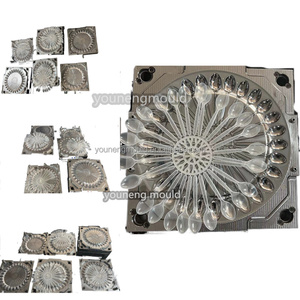
Plastic forks are one of the most common single-use tableware found in restaurants, cafes, and schools. They are a type of cutlery made from plastic materials for food consumption. Due to their affordability and convenience, plastic forks have become a popular choice for catering events, outdoor activities, and fast food establishments. However, plastic forks making molds are not biodegradable, making them a significant contributor to environmental pollution. This has led to increased scrutiny and demand for more sustainable alternatives.
Plastic forks are typically made from polypropylene (PP), polystyrene (PS), and polyethylene (PE). These materials are lightweight, durable, and easy to produce, making them ideal for disposable cutlery. There are various shapes and sizes of plastic forks, including standard forks, dessert forks, salad forks, and larger ones like serving forks. They may also come in different colors and designs to match tableware and enhance the dining experience.
There are many types of plastic forks. They are categorized based on the material used, the design or intended use, and their sustainability features.
Material-based classification
Plastic forks are made from various materials. The most common is polypropylene, a tough and flexible plastic. There are also polystyrene and polyethylene plastic forks. There are biodegradable materials and composites for sustainable options.
Design-based classification
Plastic forks for different purposes come in different designs. Cocktail forks have short tines and are used for appetizers and garnishes. Dessert forks are smaller than regular forks and are used for desserts. Salad forks are slightly larger than dessert forks and are used for salads and appetizers. Buffet forks are larger and more robust, suitable for a variety of dishes. Cake forks have serrated edges to cut through cakes and pastries.
Sustainability-based classification
Due to environmental concerns, there is a push for sustainable plastic fork options. Biodegradable forks break down over time and are made from materials like PLA, which is derived from cornstarch. Reusable plastic forks are made from durable materials and are designed to be washed and reused multiple times. Forks can also be made from recycled materials, including recycled plastic and paper. Eco-friendly plastic forks may also have a reduced carbon footprint and use less plastic in their design.
The design of the plastic fork moulds is crucial for producing high-quality utensils. It involves creating a cavity in the mould that matches the desired shape of the fork. Here's an overview of key aspects related to this design.
Cavity Design:
The cavity of the fork mould must match the shape of the fork. It has to be very precise to ensure that the fork does not need much trimming when it is removed from the mould. The design process starts with computer-aided design (CAD) software. This software allows engineers to create a detailed model of the fork. All the features of the fork are considered in the CAD model. These features include tines, handle shape, depth, and any other decorative elements. During the design of the cavity, the engineers also consider the material that will be used to make the forks. They also consider how the plastic will flow into the mould during production. This is important so that all parts of the fork are formed correctly and the production cycle is as fast as possible.
Core and Part Design:
The core of the fork mould is as important as the cavity. It creates the fork's features that are not seen on the outside. For example, the core might shape the spaces between the tines. The core and cavity must fit perfectly to create a complete fork. This is called "matching." If they do not match perfectly, the fork will have extra plastic along the seams, which is undesirable.
Mould Materials:
Moulds for plastic forks are made from materials that can withstand the heat and pressure of injection moulding. Steel is a popular choice because it is strong and can last a long time, even with repeated use. Some moulds use aluminum because it heats up and cools down quickly. This is useful for processes that need quick cycles. Another consideration in material selection is the finish of the mould. A smooth finish is needed so that the forks produced will also be smooth. Sometimes, textures are added to the mould surface to make forks with better grip or aesthetic qualities.
Ventilation and Ejection System:
Mould design also includes systems for venting air and ejecting finished forks. Venting is essential because, without it, air bubbles can form in the plastic, leading to defects. Ejection systems are needed to push the finished forks out of the mould so that the next cycle can begin. Some common types of ejector systems are ejector pins, plates, and blades. Their use depends on the size and complexity of the fork being produced.
Plastic forks are a very useful kitchen tool, and making moulds with them has many applications. Their detailed teeth and tines can create patterns, textures, and impressions in different materials. These are some scenarios where plastic forks are helpful for mould making.
Food industry
Plastic forks are used to make moulds for food presentation and garnishing. The fork tines create consistent patterns on the food surface, such as the fluted texture on the top of a cupcake or the decorative lines on a pie crust. Forks can also be used to make impressions in dough or form fruits and vegetables into shaped decorations.
Craft and DIY projects
Plastic forks help make moulds for various creative projects. The tines of the forks are used to make textures on clay, playdough, or fondant. The moulds can then produce consistent patterns on every item. The forks also help create 3D models. When joined together, they form intricate shapes. The forks can be painted to look like the original model or used as a base for other materials.
Jewellery making
Plastic forks are used to make moulds for resin jewellery. The fork tines create unique shapes and patterns in the resin. The fork handles are also used to make moulds for rings and bracelets. Their curved shape allows for the production of wearable pieces with interesting designs. Fork tines can add texture to the jewellery, making the pieces more visually appealing.
Soap and candle making
Forks can create moulds for soaps and candles. The fork tines produce decorative patterns on the surface of the soap bars or candles. Using forks to make moulds is a simple way to add unique designs to these products. It increases their visual appeal and makes them more attractive to customers.
Educational purposes
Moulds made from plastic forks are used to teach concepts in science and art classes. Students learn about casting and imprinting by making moulds with forks. They explore different materials that can be used for casting, such as plaster and clay. Forks are also used in art lessons to demonstrate how tools can create textures and patterns in various art forms.
Product Requirements:
Fork makers must clearly define the specific features and characteristics of the plastic forks they intend to produce. This includes details such as the size, shape, style, and any unique design elements that the forks should have. By establishing these product requirements, the fork maker can ensure that the mould is designed to produce forks that meet their exact specifications.
Material Selection:
Choosing the right material for the mould is crucial. Commonly used materials for moulds include steel, aluminum, and various alloys. The material selection should be based on factors such as the expected production volume, the type of plastic being used, and the budget available for the mould. Each material has its advantages and disadvantages, and the choice should align with the overall goals of the fork maker.
Cost Considerations:
Plastic fork moulds can be costly, so it's essential to evaluate the cost and budget for the mould. This includes considering the initial mould cost, maintenance expenses, and any potential repairs that may be needed over time. Cost considerations are vital to ensure that the mould remains economically viable for the fork maker.
Mould Design Flexibility:
Having a mould that allows for some design changes and adjustments is beneficial. This flexibility enables the fork maker to make minor modifications to the fork designs without needing to create an entirely new mould. It can save time and reduce costs when introducing small design changes.
Production Efficiency:
Fork makers should consider how quickly the mould can produce plastic forks. The faster the production process, the more efficient it is. Factors such as cycle time, ease of plastic injection, and overall production speed should be evaluated to ensure that the mould supports efficient and timely production of plastic forks.
Quality Control:
Implementing effective quality control measures throughout the mould-making process is essential. This involves inspecting and testing various aspects of the mould to ensure it meets the required standards. By maintaining quality control, the mould can be trusted to produce plastic forks of consistent quality and reliability.
Supplier Collaboration:
Collaboration with the mould supplier is crucial. Fork makers should work closely with the supplier to communicate their needs and expectations clearly. This collaborative approach allows the supplier to provide a mould that aligns with the fork maker's goals and requirements. Additionally, it enables the fork maker to benefit from the supplier's expertise and support throughout the process.
Testing and Prototyping:
Before finalizing the mould, it's advisable to conduct testing and prototyping. This involves creating a test version of the mould and using it to produce plastic forks on a small scale. By testing the prototype, any issues or shortcomings in the mould can be identified and rectified before full-scale production begins, reducing the risk of costly mistakes later on.
Q1: Can people reuse plastic forks?
A1: Plastic forks are usually single-use and intended to be used once and thrown away. They may not be strong enough for multiple uses, and reusing them could raise hygiene issues. However, if they are still clean and have not been damaged, they can be reused for non-food purposes.
Q2: Do plastic forks biodegrade?
A2: Plastic forks take a long time to break down, contributing to environmental pollution. Unlike biodegradable utensils, which can decompose naturally, traditional plastic forks remain in landfills for centuries, posing a significant ecological threat.
Q3: Can people recycle plastic forks?
A3: Recycling regulations differ based on location and the recycling facility's capabilities. Many places do not accept plastic cutlery due to contamination and sorting difficulties. It is essential to clean the utensils and check the local recycling guidelines to know more.
Q4: How are plastic forks molds tested for quality assurance?
A4: Forks made from plastic molds are subjected to quality assurance through visual inspections, measurement comparisons, and performance tests. These processes identify defects, ensure size conformity, and evaluate the utensil strength, respectively, ensuring the mold produces acceptable forks.
Q5: How can plastic forks be stored to ensure their longevity?
A5: Plastic forks should be kept in a cool, dry place away from direct sunlight to ensure longevity. Storing them in airtight containers can protect them from dust and moisture, maintaining their integrity and making them ready for use when needed.